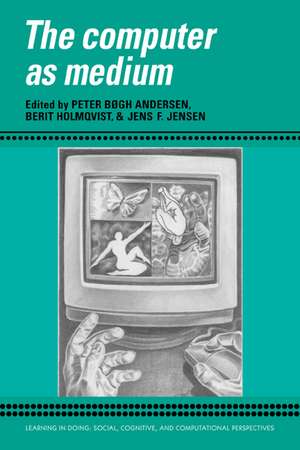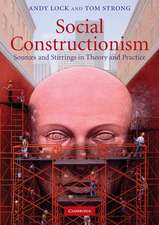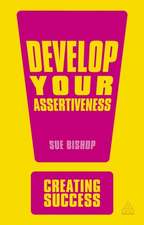The Computer as Medium: Learning in Doing: Social, Cognitive and Computational Perspectives
Editat de Peter Bxgh Andersen, Berit Holmqvist, Jens F. Jensenen Limba Engleză Paperback – 22 mar 2007
| Toate formatele și edițiile | Preț | Express |
|---|---|---|
| Paperback (1) | 362.69 lei 6-8 săpt. | |
| Cambridge University Press – 22 mar 2007 | 362.69 lei 6-8 săpt. | |
| Hardback (1) | 900.82 lei 6-8 săpt. | |
| Cambridge University Press – 24 mar 1994 | 900.82 lei 6-8 săpt. |
Din seria Learning in Doing: Social, Cognitive and Computational Perspectives
-
 Preț: 311.66 lei
Preț: 311.66 lei - 9%
 Preț: 695.96 lei
Preț: 695.96 lei -
 Preț: 319.43 lei
Preț: 319.43 lei -
 Preț: 228.66 lei
Preț: 228.66 lei -
 Preț: 201.39 lei
Preț: 201.39 lei - 11%
 Preț: 493.04 lei
Preț: 493.04 lei -
 Preț: 281.88 lei
Preț: 281.88 lei -
 Preț: 431.40 lei
Preț: 431.40 lei - 14%
 Preț: 900.82 lei
Preț: 900.82 lei -
 Preț: 326.53 lei
Preț: 326.53 lei -
 Preț: 346.50 lei
Preț: 346.50 lei -
 Preț: 296.65 lei
Preț: 296.65 lei -
 Preț: 292.45 lei
Preț: 292.45 lei - 20%
 Preț: 279.91 lei
Preț: 279.91 lei - 11%
 Preț: 459.10 lei
Preț: 459.10 lei -
 Preț: 357.13 lei
Preț: 357.13 lei - 11%
 Preț: 526.58 lei
Preț: 526.58 lei - 14%
 Preț: 784.65 lei
Preț: 784.65 lei -
 Preț: 320.66 lei
Preț: 320.66 lei - 11%
 Preț: 512.98 lei
Preț: 512.98 lei -
 Preț: 332.97 lei
Preț: 332.97 lei - 11%
 Preț: 690.80 lei
Preț: 690.80 lei - 11%
 Preț: 444.70 lei
Preț: 444.70 lei -
 Preț: 324.15 lei
Preț: 324.15 lei -
 Preț: 350.97 lei
Preț: 350.97 lei -
 Preț: 392.00 lei
Preț: 392.00 lei - 20%
 Preț: 516.51 lei
Preț: 516.51 lei -
 Preț: 330.33 lei
Preț: 330.33 lei - 14%
 Preț: 786.15 lei
Preț: 786.15 lei - 5%
 Preț: 321.87 lei
Preț: 321.87 lei -
 Preț: 350.21 lei
Preț: 350.21 lei -
 Preț: 321.27 lei
Preț: 321.27 lei - 14%
 Preț: 726.60 lei
Preț: 726.60 lei -
 Preț: 339.96 lei
Preț: 339.96 lei
Preț: 362.69 lei
Nou
Puncte Express: 544
Preț estimativ în valută:
69.40€ • 72.46$ • 57.44£
69.40€ • 72.46$ • 57.44£
Carte tipărită la comandă
Livrare economică 05-19 aprilie
Preluare comenzi: 021 569.72.76
Specificații
ISBN-13: 9780521035804
ISBN-10: 0521035805
Pagini: 508
Dimensiuni: 150 x 228 x 29 mm
Greutate: 0.74 kg
Editura: Cambridge University Press
Colecția Cambridge University Press
Seria Learning in Doing: Social, Cognitive and Computational Perspectives
Locul publicării:New York, United States
ISBN-10: 0521035805
Pagini: 508
Dimensiuni: 150 x 228 x 29 mm
Greutate: 0.74 kg
Editura: Cambridge University Press
Colecția Cambridge University Press
Seria Learning in Doing: Social, Cognitive and Computational Perspectives
Locul publicării:New York, United States
Cuprins
Series foreword; Preface; Contributors; Part I. Computer-Based Signs: Introduction Peter Bøgh Andersen; 1. A semiotic approach to programming Peter Bøgh Andersen; 2. Structuralism, computation and cognition: the contribution of glossematics David Piotrowski; 3. The shortest way between two points is a good idea: signs, Peirce and theorematic machines Keld Gall Jørgensen; 4. Logic grammar and the triadic sign relation Per Hasle; 5. Meaning and the machine: toward a semiotics of interaction Per Aage Brandt; Part II. The Rhetoric of Interactive Media: Introduction Berit Holmqvist; 6. Narrative computer systems: the dialectics of emotion and formalism Berit Holmqvist and Peter Bøgh Andersen; 7. Interactive fiction: artificial intelligence as a mode of sign production Peter Bøgh Andersen and Berit Holmqvist; 8. Plays, theatres and the art of acting in the eighteenth century: a formal analysis Jens Hougaard; 9. The meaning of plot and narrative Jørgen Bang; 10. Face to interface Berit Holmqvist; 11. Drawing and programming Bjørn Laursen and Peter Bøgh Andersen; 12. Hypermedia communication and academic discourse: some speculations on a future genre Gunnar Liestøl; Part III. Computers In Context: Introduction Jens F. Jensen; 13. Computer culture: the meaning of technology and the technology of meaning Jens F. Jensen; 14. One person, one computer: the social construction of the personal computer Klaus Bruhn Jensen; 15. Hi-tech network organizations as self-referential systems Lars Qvortrup; Comment: disturbing communication Peter Bøgh Andersen; 16. Dialogues in networks Elsebeth Korsgaard Sorensen; 17. Historical trends in computer and information technology Jens Christensen; Comment: the history of computer-based signs Peter Bøgh Andersen; 18. A historical perspective on work practices and technology Randi Markussen; 19. Hypertext: from modern utopia to post-modern dystopia? Bjørn Sørenssen; Index.
Descriere
The Computer as Medium discusses the communicative and organizational nature of computer networks within a historical perspective.














